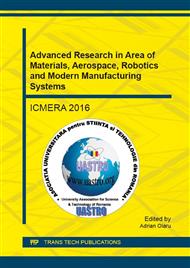[1]
Keller T., Veneman J., Robotics for Neurorehabilitation: Current State and Future Challenges, Applied Mechanics and Materials, Vol. 245, pp.3-8, (2013).
DOI: 10.4028/www.scientific.net/amm.245.3
Google Scholar
[2]
RELIVE, online at: http: /www. omtr. pub. ro/cesit/granturi/RELIVE/parteneri. html, (2016).
Google Scholar
[3]
Briscoe R., Grush R. Action-based Theories of Perception. Stanford Encyclopedia of Philosophy, 2015. http: /plato. stanford. edu/entries/action-perception.
Google Scholar
[4]
United Nations. Accessibility for the Disabled - A Design Manual for a Barrier Free Environment. Online at: http: /www. un. org/esa/socdev/enable/designm/AD2-09. htm.
Google Scholar
[5]
Ciobanu I., Complex Mechatronic System for Gait Rehabilitation in Patients with Disabling Neurological Conditions – DhD Thesis, 2016, Carol Davila University of Medicine, Bucharest.
Google Scholar
[6]
Matthis JS, Barton S, Fajen B. The biomechanics of walking shape the use of visual information during locomotion over complex terrain. J Vis. 2015, 15(3), 10.
DOI: 10.1167/15.3.10
Google Scholar
[7]
Webster J, Jones S, Blanton P, Gross R, Beissel G, Wofford G. Visual scanning training with stroke patients. Behavior Therapy, Volume 15, Issue 2, March 1984, 129-143.
DOI: 10.1016/s0005-7894(84)80015-5
Google Scholar
[8]
Mohan S. Anthropometric standards. http: /drsmau. in/anthropometric. php.
Google Scholar
[9]
Burton HE . The optics of Euclid. Journal of the Optical Society of America 1945, 35(5): 357 372., Gillam B, Borsting E. The role of monocular regions in stereoscopic displays. Perception 1988, 17 (5), 603–608.
DOI: 10.1068/p170603
Google Scholar
[10]
Epstein W, Rogers S., ed by. Perception of Space and Motion. A volume in Handbook of Perception and Cognition. ISBN: 978-0-12-240530-3, (1995).
Google Scholar
[11]
Kay KN, Weiner KS, Grill-Spector K. Attention Reduces Spatial Uncertainty in Human Ventral Temporal Cortex. Current Biology 2015, 25, 595–600.
DOI: 10.1016/j.cub.2014.12.050
Google Scholar
[12]
Previc FH. The Neuropsychology of 3-D Space. Psychological Bulletin 1998, Vol. 124, No. 2, 123-164.
Google Scholar
[13]
de Souza NS, Gomes Martins AC, Alexandre AJ, et al. The influence of fear of falling on orthostatic postura control: a systematic review. Neurology International 2015; vol. 7: 6057, 62-65.
Google Scholar
[14]
Perry J, Burnfield J.M. Gait Analysis. Stroke Rehabilitation. Normal and Pathological Function. Second Edition. Slak Incorporated, 2010, ISBN: 978-1-55642-766-4, Pag. 304.
DOI: 10.1302/0301-620x.92b8.0921184a
Google Scholar
[15]
von Schroeder HP, Coutts RD, Lyden PD, Billings E Jr, Nickel VL. Gait parameters following stroke: a practical assessment. J Rehabil Res Dev. 1995, 32(1): 25-31.
Google Scholar
[16]
Cojan-Carlea NA, Badea R.I., Iliescu A N, Ciobanu I, Berteanu M. Instrumented Gait Analysis for Assessing the Efficiency of a Complex Rehabilitation Program in Patients with Stroke – a Case Study. Applied Mechanics and Materials Vol. 811, 2015, 347-352.
DOI: 10.4028/www.scientific.net/amm.811.347
Google Scholar


